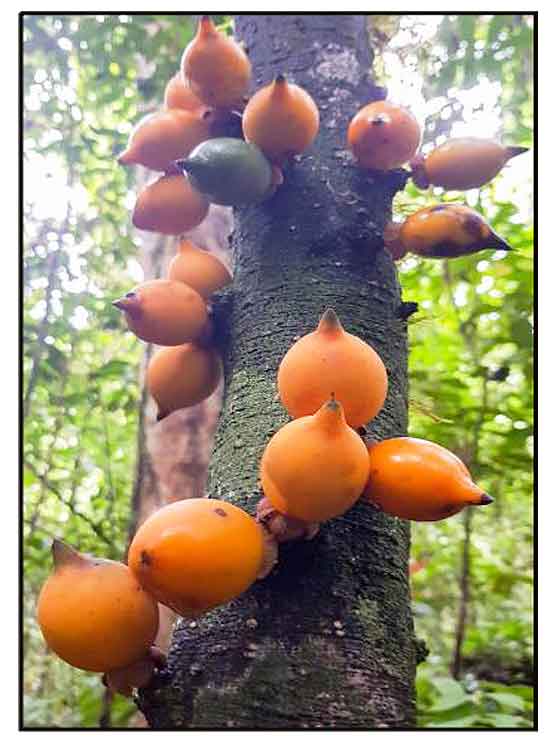 Gen info Gen info
- Diospyros is a genus of over 700 species in deciduous and evergreen trees and shrubs.
- Etymology: The genus name Diospyros derives from Greek diospyros from dios and pyros, literally meaning "Zeus's wheat" or "divine food" or "divine fruit". The specific epithet cauliflora refers to cauliflory, a botanical terms referring to plants that flower and fruit from the main stems or wood trunks, rather than new growth or shoots.
Botany
Diospyros cauliflora is a small or medium-sized forest tree, 15-60 ft high. Bark is dark-brow to black, thin, smooth, breaking like flint when struck; slash black outside, pale pink turning ochrous-yellow inside. Sapwood is white, rapidly becoming bright yellow. Leaves are alternate, obovate to elliptical, 10-25 x 2-8 cm, with a bulging appearance due to its bulged secondary leaves. Flowers are fragrant; corolla white. Fruits are berries, borne in fascicles on the branches and clustered around the main trunk; green when young, turning yellow on ripening, round, soft surface, sharp tip and blunt base. Flower and fruit are on the surface of the primary trunk. (2) (8)
Evergreen tree, up to 8 m high, twigs unarmed. Leaves oblong or lanceolate, 11–15 by 3–8 cm, base acute or slightly cuneate, apex cuspidate or caudate, chartaceous to subcoriaceous, glabrous on both surfaces; secondary nerves 8–12 pairs, arched and anastomosing well away from the margin, impressed on upper surface, prominent on lower surface; scalariform veins inconspicuous on lower surface; reticulate veins indistinct; petiole 5–10 mm long, pubescent later glabrescent. Male flowers cymose (usually tufted on trunk), 4(–5)-merous; pedicel 2–5 mm long, densely black-hairy. Calyx campanulate, ± 2 mm long, divided to two thirds, black-hairy outside, glabrous inside. Corolla ovoid or urceolate, 2–3 mm long, divided to a quarter; tomentose or woolly outside, glabrous inside. Stamens 16–20, pubescent. Rudimentary ovary hirsute. Female flowers cymose or solitary (usually on trunk), 4(–5)-merous; pedicel 2–3 mm long, pubescent. Calyx broadly campanulate, divided to half or to three fifths, pubescent outside, glabrous inside. Corolla ovoid or urceolate, divided to a third, woolly outside, glabrous inside. Ovary ovoid, tomentose, 6-locular; style solitary, tomentose. Staminodes 8–10, glabrous. Fruit on trunk and branches, ovoid or ellipsoid, 1.5–3 by 1.5–2.5 cm, leathery woody, glabrous, rounded or obtuse at both ends, minutely apiculate at apex; fruiting calyx divided to the base, pubescent on both sides; lobes reflexed and undulate but not plicate and with inconspicuous nerves; fruit-stalk 3–5 mm long; endosperm smooth. (3)
 Distribution Distribution
- Native to the Philippines.
- Also native to Andaman Is., Borneo, Cambodia, Jawa, Lesser Sunda Is., Malaya, Maluku, Myanmar, Nicobar Is., Sulawesi, Sumatera, Thailand, Vietnam. (1)
- Grows primarily in the wet tropical biome.
- In lowland to medium elevation dipterocarp and liimestone forests.
Constituents
- Phytochemical study of chloroform extract of roots of D. cauliflora yielded 3,4-dihydro-4ß,6-dihydroxy-5-methoxy-2α-methyl-1(2H)-naphthalenone), lupeol, betulinic acid, 7-hydroxy-4’-methoxyflavone (pratol), vanillic acid, 2,5-dimethyl-7-hydroxychromone and nicotinamide. (see study below) (4)
- Study of chloroform soluble fraction of methanol extract of roots isolated lupeol, betulinic acid, nicotinamide, 7-hydroxy-4'-methoxyflavone (1), 2,5-dimethyl-7-hydroxychromone (2) and a new compound 3,4-dihydro-4β,6-dihydroxy-5-methoxy-2α-methyl-1(2H)-naphthalenone (3).
(5)
- Studies on wood have isolated diosindigo A, lupeol, betulin, betulinic acid, ursolic acid, sterols. Study of stem bark yielded elliptinone and ebenone. (7)
Properties
- Studies have suggested repellent, cytotoxic, antiproliferative properties.
Parts used
Roots, fruits.
Uses
Edibility
- Many Diospyros species are cultivated for their edible fruit. For D. cauliflora, there is no information found on its edibility.
Folkloric
- No reported folkloric medicinal use in the Philippines.
-
In Malaysia, plant used for treatment of cough.
Others
- Dye: Fruits used for dyeing nets and clothes.
 Studies Studies
• Repellency Against Spider Mite Tetranychus urticae: Study evaluated the crude extracts of Diospyros cauliflora and Duabanga grandiflora against Tetranychus urticae female. Crude chloroform extract of D. cauliflora showed higher repellency (45.6%). Both extracts reduced number of eggs with a maximum of 92.2 and 94.6% at highest concentration. Both plants exhibited higher repellency effect than toxicity. Crude chloroform extract of D. cauliflora at 4 ad 8% repelled mites at rates significantly different from control. (see constituents above) (4)
• Lupeol / Antiproliferative Activity / HeLa Cells / Roots: Study evaluated the antiproliferative activities and molecular mechanisms of crude hexane extract of roots of Diospyros cauliflora and D. filipendula. Lupeol was isolated from D. cauliflora. MTT assay using HeLa cells as a model system showed lupeol induced HeLa cell death in a dose-dependent manner associated with rounding cells, membrane blebbing and apoptotic body with IC50 of 20 ± 2.6 µg/ml. (6)
Availability
- Wild-crafted.
- Seeds in the cybermarket.
|

![]()



 Gen info
Gen info

